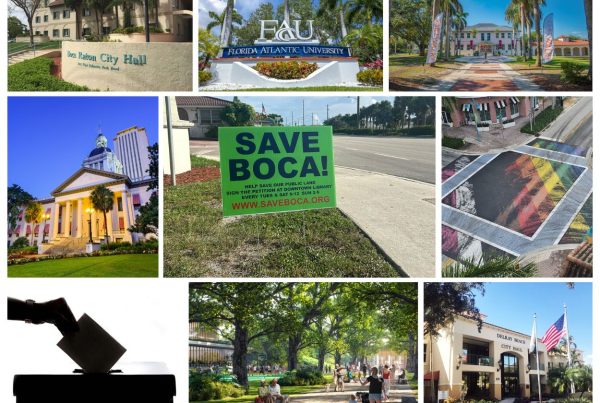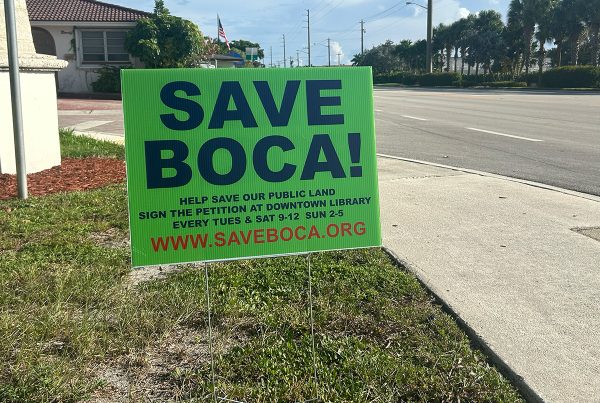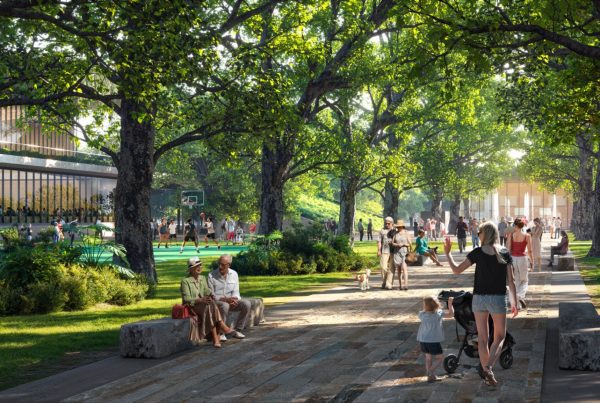The Palm Beach County Commission on Ethics notified Boca Raton City Manager Leif Ahnell just before Tuesday night’s city council meeting that the council could not ask for a review of the 2013 advisory opinion stating that Mayor Susan Haynie could vote on matters related to James and Marta Batmasian.
Instead, Ahnell said, any such request would have to come from Haynie, since she sought the opinion. Haynie said she would submit the request and would notify her colleagues of the commission’s response.
But as Executive Director Mark Bannon pointed out, the commission doesn’t advise elected officials if their votes aligned with an opinion. The commission only could advise Haynie about future votes that involve the Batmasians. So the response to whatever Haynie requests is unlikely to resolve the controversy.
The key allegation in The Palm Beach Post story is that, despite the opinion, Haynie should not have voted on Batmasian-related matters. A company that Susan Haynie started and is now owned by Haynie’s husband, Neil Haynie, is the property manager for the master association of Deerfield Beach condo development in which the Batmasians own 1,400 of the 1,600 units. The company has had the $12,000 annual contract since 2010.
In an article published today, The Post claimed that Bannon’s letter “confirmed” the paper’s allegation. The Post cites this portion of Bannon’s letter:
“In approving this advisory opinion the COE was careful to specifically recognize the following key fact: ‘The investor is neither the applicant nor the developer of the project, but has an interest in the underlying property for the proposed project.’ That fact written into the advisory opinion serves to limit this opinion to votes not involving the applicant or developer of a property.”
This morning, however, Bannon said he had “no comment” on The Post’s assertion. “That’s their wording.” On Tuesday night Haynie accused Bannon of “cherry-picking” from the opinion, citing another portion that refers to the condo association.
In his letter, Bannon reiterated a key point of discussion: that the opinion was “based on a very specific set of facts provided by the city attorney, and is one that should be narrowly construed to that particular fact pattern.”
Most likely, the next step will be an investigation of Haynie’s votes by the ethics commission. It can do so in response to a complaint, which BocaWatch Publisher Al Zucaro surely has filed or will file. Zucaro has been pushing the Batmasian issue since he ran against Haynie last March. Political motivation by itself, however, is not a credible defense for the mayor.
With an investigation, the commission staff would determine if there is probable cause for charges. If the staff finds probable cause, the five-member board would hear the charges and render a verdict.
The issue goes beyond Boca Raton, since Haynie is running for the county commission. For now, though, the issue is the city council’s problem. Discussion Tuesday night was diplomatic but strained.
Much is at stake for the city and especially for Haynie. Though her previous votes involved mostly minor issues concerning the Batmasians, in the pipeline for council approval or denial is a major redevelopment of Royal Palm Place, which the Batmasians own. Residents need clarity on this issue, from whatever source.
Old School Square update

Concept view of a proposed green market at Old School Square.
The Delray Beach City Commission may have done a lot for Old School Square without seeming to do much.
On the agenda for last week’s meeting was a “presentation regarding the components of the Old School Square master plan.” Some commissioners expressed confusion, wondering whether they were supposed to give final approval to something that remains conceptual.
Mayor Cary Glickstein acknowledged that the issue has gone “back and forth” between the city, the community redevelopment agency and Old School Square. Commissioner Mitch Katz said, “It feels like ‘Groundhog Day.’ At one point, a CRA consultant proposed turning the front of Old School Square into a busy, European-type plaza. The commission protested. Plans got scaled back.
Local architects Bob Currie and Jess Sowards presented the plan, which breaks down into three phases. The first is what Old School Square Executive Director Rob Steele calls “aesthetic and passive use improvements to the park perimeter, as this is the most visible aspect of the plan.”
Residents made clear that they want a passive, approachable border around Old School Square. There will be more shade and better lighting. Glickstein noted that the commission helped to set this in motion with its decisions to reduce the number of large festivals in the park and to move the new, aluminum Christmas tree north and east of where its wooden predecessor had stood.
The second phase would focus on the eastern portion of the park. Steele said Old School Square wants to “create a year-round home for the beloved Green Market.” Currie has suggested a fountain on the tree site where children could play. That would be similar to the popular Centennial Fountain in downtown West Palm Beach.
Currie also talked about glass doors from the parking garage that could allow “pop-up shops” for vendors and generally increase activity in that area. At last week’s meeting, Sowards said a lot of the discussion has dealt with the question of “how we can activate the space.”
Finally, the plan envisions a covered amphitheater, not just the current Pavilion. Currie said it could seat $2,500 people and perhaps more. The amphitheater would come last, Steele said, “Unless funding for this feature materializes earlier in the project.”
Lack of money is the main reason that the plan—which by one early estimate could cost $12 million— remains mostly conceptual. Steele said Old School Square was able to take money from last year’s budget to buy all the new signs in the first phase. There’s no money this fiscal year for the second phase. “It is our great hope,” Steele said, “that the commission seated after the March election will provide direction to fund the thoughtful improvement of this cornerstone of our community.”
The commission, however, would like to see Old School Square chip in more. So by last week blessing the direction of the plan, the commission signaled that Old School Square can begin raising private money in earnest. As Currie told me, his firm’s renderings “don’t say what to build, but they show where things could go.”
As things progress, the commission will retain a say in the plan. Though the historic preservation board will have input, Glickstein dismissed the idea that the board would have “the final say.”
One cannot overestimate how much Old School Square has meant to the revival of downtown Delray Beach. It has been more than three decades since a group of residents, led by Historical Society Vice President Frances Bourque, envisioned a project that would save the city’s old elementary school and high school.
Today, Old School Square is the Cornell Museum— with its just-completed interior renovation—the Crest Theater, the Creative Arts School, the Fieldhouse and the Pavilion. Old School Square has a budget of roughly $3.4 million and draws one-third more people than the Kravis Center for the Performing Arts.
So if completing the master plan seems a challenge, it’s nothing like the challenge of more than 30 years ago.
Setback for Publix?
Delray Beach has suffered a setback in the effort to put a grocery store on West Atlantic Avenue, but the setback could be temporary.
I had reported that the Publix real estate committee would vote this month whether to move forward with a store on one of the blocks that the community redevelopment agency had assembled east of the Fairfield Inn. The combined property was supposed to have been the mixed-use Uptown Atlantic, but the CRA had to end the purchase agreement—after three years—because the developer could not produce financing.
Publix was the new option. A grocery store had been part of Uptown Atlantic. A private developer group proposed to build the store and lease it to Publix. The real estate committee, however, rejected the deal.
Mayor Glickstein told me Wednesday, however, that the city has been working with Publix to restructure and thus save the deal, which the CRA ultimately would have to approve.
Under the new Publix proposal, the CRA’s contract for the land would be assigned to Publix, not a developer. Publix would close on the sale 30 days after the city approves a site plan. Glickstein noted that because the commission previously approved waivers for the proposed store, site plan approval should not be problematic.
The other difference would happen the closing. Publix would require an additional 2-year extension from what the CRA had agreed to in the previous contract before Publix would have to start building the store. If Publix didn’t start construction within that time, the CRA could exercise its right to buy back the property.
Most likely, the company proposed the deal because it wants to see more of the redevelopment on West Atlantic the CRA has been promising before it commits to the store. Glickstein said that concern was the primary reason Publix rejected the timing requirements in the prior contract.
Glickstein said Publix’s real estate committee approved the revised proposal on Tuesday. CRA Chairman Annette Gray said the issue was not scheduled to come up during the agency’s special meeting Wednesday. The next CRA meeting is on Dec. 14.
Delray commission race
Based on new campaign finance reports, the Seat 3 Delray Beach City Commission race is going to be very competitive.
Incumbent Mitch Katz raised about $8,600 in October, bringing his total to slightly more than $36,000. Among Katz’s latest contributions are $1,000 from Josh Smith—the unsuccessful candidate Katz supported last March against Shirley Ervin Johnson—and $500 from the firefighters union.
For Ryan Boylston, owner of the advertising/marketing company Woo Creative, October was his first report since filing to challenge Katz. Boylston raised almost $18,000, loaned himself another $5,000 and took $2,500 worth of in-kind contributions from Woo.
Among Boylston’s donations was $1,000 from Chuck Halberg, chairman of the Arts Garage board, and $1,000 from Fran Marincola, who owns Luna Rosa Restaurant. Another $1,000 came from Connor Lynch, chief operating officer at his family’s Plastridge Insurance. William Himmelrich, owner of Old School Bakery, gave $1,000.
Lynch’s father, Tom Lynch, is a former mayor of Delray Beach. Another former mayor, Jeff Perlman, gave Boylston $500. Bruce Bastian gave $250. Bastian lost to Katz in 2015.
Still another $500 came to Boylston from Noel Pfeffer. He was city attorney from 2014 to 2016. Katz clashed with Pfeffer and accused former Commissioner Jordana Jarjura of an ethical conflict when she tried to keep Pfeffer on a temporary basis after he left for private practice. Katz later apologized to Jarjura.
Boylston’s media links
This will be the second straight election in which a local candidate has a media affiliation.
In Boca Raton last March, it was Al Zucaro, publisher of BocaWatch. When he challenged Mayor Susan Haynie, Zucaro said he would relinquish day-to-day operation of the group’s website.
Now it’s Ryan Boylston, who has been publisher of the monthly Delray Newspaper. It also has a Boca Raton edition. Boylston told me Wednesday that he “stepped down” from his role with Four Story Media Group after filing to run against Katz in Seat 3. If Boylston wins in March, he will divest himself from the company.
Of course, BocaWatch continued to praise Zucaro and bash Haynie even after Zucaro’s announcement. There’s a big difference between a website that can be constantly updated and a monthly newspaper, but the same may happen after Boylston’s decision. Jeff Perlman remains an officer at Four Story Media.
Boca retirements
Boca Raton officials have been worried about a wave of retirements among department heads. City Manager Leif Ahnell just filled one key position.
Parks and Recreation Services Director Mickey Gomez is retiring this week after 33 years with the city. Wednesday’s retirement party for the affable, competent Gomez drew a deservedly large crowd.
Gomez’s successor is Michael Kalvort. He had held similar positions in Virginia Beach, Va., and Chesapeake, Va., but Kalvort has lots of Florida connections. He has degrees from the University of Florida and Nova Southeastern University and ran the parks department in Cape Coral, on the Gulf coast.
CORRECTION
On Tuesday, I wrote about the Arts Warehouse in Delray Beach, whose soft opening is Friday.
I stated that rents for artists would last one to two years. Director Jill Brown said the rents can last up to three or four years. I also quoted Brown as saying, “These people can’t stay here forever.” Her preferred sentiment is, “This is an incubator, and the artists will max out after three or four years.”







